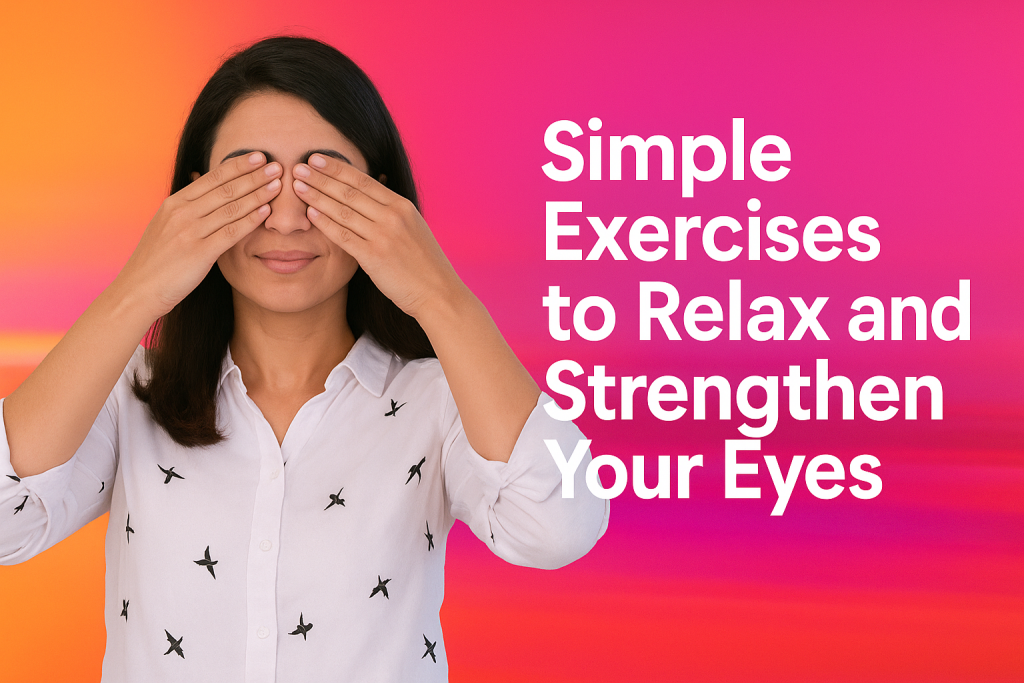
In today’s digital world, most of us spend hours staring at screens — from smartphones and laptops to televisions and tablets. This constant visual demand can leave our eyes feeling strained, tired, or even dry. Just like the muscles in your arms and legs, your eyes also benefit from regular exercise. Eye exercises cannot replace corrective lenses or cure refractive errors like myopia, hyperopia, or astigmatism, but they can improve comfort, reduce fatigue, and help your eyes function more efficiently. Think of them as stretching for your vision — simple habits that can make a big difference in your daily life.
In this article, we’ll explore a series of practical eye exercises, how they work, and why you should consider making them part of your wellness routine.
Why Eye Exercises Matter
Eye muscles are constantly at work, adjusting focus, guiding movement, and coordinating with the brain to process images. Prolonged use, especially during screen time, can cause tension and fatigue. This is why you might feel your eyes burning after a long workday or notice blurred vision after scrolling for hours. Eye exercises act as a reset button. They relax tight muscles, encourage better blood flow, and give your vision a much-needed break. Over time, practicing them regularly can help you feel more comfortable, alert, and focused.
1. Palming: A Moment of Relaxation
Palming is one of the easiest and most effective eye exercises. The technique is rooted in relaxation methods often recommended in yoga and holistic health practices.
How to do it:
Rub your palms together briskly until they feel warm.
Close your eyes gently.
Cup your hands over your closed eyes without pressing on them.
Let the warmth and darkness relax your eyes for 30 seconds to a minute.
This simple practice reduces eye strain and provides instant relief, especially after extended computer use. The darkness allows your optic nerves to rest, while the warmth from your palms adds a soothing effect. Many people also find palming calming for the mind, making it a mini-meditation for both body and spirit.
2. Eye Rolling: Flexibility for Your Vision
Eye rolling may sound playful, but it’s actually a valuable way to stretch and strengthen the muscles that control eye movement.
How to do it:
Sit comfortably and keep your head still.
Slowly roll your eyes in a clockwise direction, making a full circle.
Repeat 5–10 times.
Switch directions and roll counterclockwise.
This exercise improves flexibility, loosens stiffness, and stimulates circulation. Think of it like rotating your shoulders after sitting too long — it helps release built-up tension. Done daily, eye rolling can make your eyes feel less “tight” and more refreshed.
3. Focus Shifting: Training Adaptability
Our eyes are designed to constantly shift focus between near and far objects. However, with so much close-up screen time, we often neglect long-distance focusing, leading to strain. Focus shifting helps restore balance.
How to do it:
Hold a pen or your finger about 6 inches away from your face.
Focus on it for 10 seconds.
Then shift your gaze to an object in the distance — perhaps across the room or out a window.
Focus on that distant object for 10 seconds.
Repeat the cycle 10 times.
This exercise is excellent for combating digital eye strain and helps train your eyes to adjust more smoothly between different distances. Over time, it improves visual flexibility and reduces that “tired” feeling after long study or work sessions.
4. Figure Eight Tracing: Coordination and Control
Another highly effective practice is tracing a figure eight with your eyes. It enhances coordination and strengthens the muscles responsible for controlled eye movement.
How to do it:
Imagine a large “8” or infinity symbol lying on its side about 10 feet in front of you.
Slowly trace its shape with your eyes for 30 seconds.
Switch directions and trace for another 30 seconds.
This movement challenges your eyes to follow smooth, controlled patterns. It not only helps in reducing stiffness but also boosts concentration and focus. Many athletes and professionals who rely on quick eye movements — such as pilots or surgeons — use similar techniques to maintain precision.
5. The 20-20-20 Rule: An Everyday Habit
While not an exercise in the strictest sense, the 20-20-20 rule is a powerful habit for protecting your vision. The concept is simple: every 20 minutes, look at something 20 feet away for at least 20 seconds.
This quick reset relaxes the eye muscles, prevents digital fatigue, and reduces the risk of developing computer vision syndrome (CVS). Pairing the 20-20-20 rule with exercises like palming or focus shifting creates a complete routine for healthy eyes.
Extra Tips for Maximizing Results
Blink more often: Screen use reduces blink rate, causing dryness. Consciously blinking keeps your eyes moist and refreshed.
Adjust your screen setup: Ensure your monitor is at eye level and about 20–24 inches from your face.
Stay hydrated: Dehydration contributes to dry eyes, so keep sipping water throughout the day.
Use good lighting: Avoid harsh glare or dim lighting when reading or working.
What Eye Exercises Cannot Do
It’s important to set realistic expectations. Eye exercises do not cure conditions like nearsightedness, farsightedness, or astigmatism. They also won’t eliminate the need for glasses or contact lenses. What they do provide is comfort, reduced fatigue, and better visual efficiency. If you have persistent eye discomfort, headaches, or vision changes, it’s best to consult an optometrist or ophthalmologist.
Making Eye Exercises Part of Your Lifestyle
Like any fitness routine, consistency is key. You don’t need to spend hours — just 5 to 10 minutes daily can make a noticeable difference. Consider incorporating exercises during work breaks, before bed, or while traveling. Over time, your eyes will feel less strained, and your focus will remain sharper.
Think of it this way: just as stretching your legs keeps you limber, stretching your vision keeps your eyes energized and ready for the challenges of modern life. With regular care, your eyes can stay comfortable and resilient despite the demands of a screen-filled world.
Final Thoughts
Your eyes are among your most valuable assets, guiding you through every detail of life. Giving them a few minutes of daily attention can help them stay healthy and refreshed. Whether it’s palming for relaxation, rolling for flexibility, or shifting focus for adaptability, these exercises are simple yet effective tools for eye wellness.
They may not replace corrective lenses, but they offer something equally important: comfort, relaxation, and long-term visual stamina. So the next time you take a break from your computer or phone, try a quick eye workout. Your future self — and your vision — will thank you.
